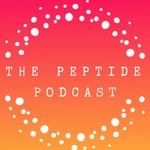The Peptide Podcast – Details, episodes & analysis
Podcast details
Technical and general information from the podcast's RSS feed.

The Peptide Podcast
The Peptide Queen
Frequency: 1 episode/8d. Total Eps: 151

Recent rankings
Latest chart positions across Apple Podcasts and Spotify rankings.
Apple Podcasts
🇨🇦 Canada - alternativeHealth
02/08/2025#58🇬🇧 Great Britain - alternativeHealth
02/08/2025#45🇺🇸 USA - alternativeHealth
02/08/2025#43🇨🇦 Canada - alternativeHealth
01/08/2025#37🇺🇸 USA - alternativeHealth
01/08/2025#48🇬🇧 Great Britain - alternativeHealth
31/07/2025#74🇺🇸 USA - alternativeHealth
31/07/2025#39🇬🇧 Great Britain - alternativeHealth
30/07/2025#47🇺🇸 USA - alternativeHealth
30/07/2025#38🇬🇧 Great Britain - alternativeHealth
29/07/2025#57
Spotify
No recent rankings available
Shared links between episodes and podcasts
Links found in episode descriptions and other podcasts that share them.
See all- https://amzn.to/3PB9DCn
84 shares
- https://amzn.to/3PyKVmg
42 shares
- https://amzn.to/3uXlFym
42 shares
RSS feed quality and score
Technical evaluation of the podcast's RSS feed quality and structure.
See allScore global : 73%
Publication history
Monthly episode publishing history over the past years.
Differences Between Semaglutide and Tirzepatide
Season 1 · Episode 110
jeudi 12 septembre 2024 • Duration 07:38
Two of the most promising treatments for obesity in recent years are semaglutide, a GLP-1 agonist, and tirzepatide, a dual GLP-1/GIP agonist. These peptides have garnered attention for their impressive efficacy in weight loss and metabolic improvement, but they differ in their mechanisms, dosing, side effects, and outcomes. In this podcast, we'll explore how these peptides compare.
Semaglutide and tirzepatide work in similar but slightly different ways for weight lossSemaglutide works by mimicking glucagon-like peptide-1 (GLP-1), a hormone that is naturally released by the gut in response to food. GLP-1 helps regulate appetite by increasing the feeling of fullness (satiety), slowing gastric emptying, and reducing the body's insulin resistance. It also stimulates insulin secretion, which helps control blood sugar levels, making it useful not only for weight loss but also for managing type 2 diabetes.
Tirzepatide activates both GLP-1 and glucose-dependent insulinotropic polypeptide (GIP) receptors. GIP is another hormone involved in insulin secretion, but it also plays a role in fat metabolism. By engaging both receptors, tirzepatide has a dual/additive impact: it not only boosts insulin sensitivity and appetite suppression (similar to semaglutide) but also enhances the body's ability to process fat and use it for energy — providing an added benefit for weight loss and metabolic health.
Tirzepatide may result in greater weight loss compared with semaglutideSemaglutide has been shown to reduce body weight by 10-15% in most clinical trials, with some patients achieving even greater weight loss (up to 17% of total body weight). Additionally, it has proven effective in reducing blood glucose levels and improving insulin sensitivity, making it a great option for patients with type 2 diabetes and obesity.
Tirzepatide has shown superior weight loss efficacy, with reductions of up to 20-25% of body weight in clinical trials. Its dual action on GLP-1 and GIP receptors may explain this enhanced efficacy. It also offers significant improvements in metabolic markers, including better glucose control and insulin sensitivity, which can especially benefit patients with obesity-related metabolic disorders (e.g., type 2 diabetes and polycystic ovary syndrome)
Semaglutide and tirzepatide have different dosesSemaglutide is typically administered as a once-weekly injection. The dosing for weight loss starts at 0.25 mg per week and gradually increases in 4-week intervals to a maintenance dose of 2.4 mg per week. The gradual titration helps minimize side effects such as nausea. Sometimes, the semaglutide dose may be increased sooner than the 4-week interval based on the person’s response to the peptide.
Tirzepatide is also administered as a once-weekly injection. The dosing for weight loss starts at 2.5 mg per week and gradually increases to a maintenance dose of 5 mg to 7.5 mg per week, with some people requiring higher doses (10 mg, 12.5 mg, or 15 mg). The dose is generally increased based on patient tolerance, similar to semaglutide but shouldn’t be increased sooner than 4 weeks.
Semaglutide and tirzepatide have similar side effectsCommon side effects of semaglutide include:
-
Nausea
-
Vomiting
-
Diarrhea
-
Constipation
-
Headache
-
Tiredness
These stomach-related side effects are usually temporary and go away on their own as the body adjusts to the medication. However, some people may experience more severe symptoms, necessitating a lower dose.
Tirzepatide shares many of the same side effects as semaglutide, including:
-
Nausea
-
Vomiting
-
Diarrhea
-
Constipation
-
Burping
-
Flatulence
-
Indigestion
Keep in mind: Tirzepatide's side effects can sometimes be more pronounced, particularly during the dose-escalation phase. Some patients may also experience signs of low blood sugar, especially if used in combination with insulin.
Semaglutide may be a better option if you have heart disease
In March 2024, semaglutide received additional FDA approval for reducing cardiovascular risk in adults with heart disease who are overweight or obese. Clinical studies show that semaglutide reduced the risk of major adverse cardiovascular events—such as heart attack, stroke, or cardiovascular death—by 20%.
Tirzepatide is currently being studied for similar cardiovascular benefits.
Semaglutide and tirzepatide may have benefits for other health conditionsSemaglutide has demonstrated positive outcomes in certain people with heart failure, and a recent study suggests potential kidney-related benefits for those with heart disease. It is also being studied as a treatment for metabolic dysfunction-associated steatohepatitis (MASH), also known as non-alcoholic steatohepatitis, a condition caused by excess fat accumulation in the liver.
Tirzepatide has shown promise for individuals with moderate-to-severe obstructive sleep apnea and may receive approval for this use by late 2024. Additionally, it is under investigation for potential benefits in cardiovascular risk reduction, heart failure, MASH, and chronic kidney disease.
In summary:
-
Mechanism: Semaglutide targets only GLP-1, while tirzepatide activates both GLP-1 and GIP receptors.
-
Efficacy: Tirzepatide has demonstrated superior weight loss results compared to semaglutide.
-
Side Effects: Both drugs have similar stomach-related side effects, though tirzepatide may be more potent and have a higher incidence of certain symptoms.
-
Dosing: Both are administered as weekly injections, but their doses differ.
Ultimately, the choice between these therapies will depend on individual patient needs, tolerance, and response to treatment.
Someone might choose tirzepatide over semaglutide for weight loss due to its greater efficacy in achieving higher levels of weight reduction and its dual mechanism that offers additional metabolic benefits. Others choose to switch from semaglutide to tirzepatide if they hit a weight loss plateau despite changing nutrition and physical activity habits.
When it comes down to it, it’s a personal choice.
Thanks again for listening to The Peptide Podcast. We love having you as part of our community. If you love this podcast, please share it with your friends and family on social media, and have a happy, healthy week!
We're huge advocates of elevating your health game with nutrition, supplements, and vitamins. Whether it's a daily boost or targeted support, we trust and use Momentous products to supercharge our wellness journey.
Momentous only uses the highest-quality ingredients, and every single product is rigorously tested by independent third parties to ensure their products deliver on their promise to bring you the best supplements on the market.
Potential of GLP-1 Agonists in Alzheimer’s Disease
Season 1 · Episode 109
jeudi 15 août 2024 • Duration 04:17
Alzheimer's disease is a type of dementia characterized by memory loss, cognitive decline, and a decline in the ability to perform daily tasks (e.g., planning and organizing). It can also affect mood and personality and impair judgment and language. Research has shown that Alzheimer’s results from amyloid plaques and neurofibrillary tangles in brain tissue, which affect communication between brain neurons.
The quest for effective treatments remains a high priority. Among the promising therapeutic avenues being investigated, GLP-1 (glucagon-like peptide-1) agonists, traditionally used for managing type 2 diabetes and weight, have garnered significant attention for their potential benefits in Alzheimer's disease. In this podcast, we’ll discuss the potential use of GLP-1 agonists in Alzheimer’s disease and how they work.
Understanding GLP-1 AgonistsGLP-1 agonists are a class of medications primarily used to enhance insulin secretion and improve glycemic control in patients with type 2 diabetes and obesity. They mimic the effects of the natural hormone GLP-1, which is involved in glucose metabolism and appetite regulation. Besides their glucose-lowering properties, GLP-1 agonists have been observed to have various effects beyond glucose control, including neuroprotective properties.
Mechanisms of Action of GLP-1 Agonists in Alzheimer's Disease-
Neuroprotection: GLP-1 agonists have been shown to exert neuroprotective effects in preclinical models of Alzheimer's disease. They may help protect neurons from damage and death, which is crucial in a disease characterized by widespread neuronal loss. The mechanisms through which GLP-1 agonists provide neuroprotection include reducing oxidative stress, inflammation, and apoptosis (cell death).
-
Amyloid Beta and Tau Pathology: Alzheimer's disease is marked by the accumulation of amyloid beta plaques and tau tangles in the brain. Some studies suggest that GLP-1 agonists might influence the pathology associated with Alzheimer's disease by reducing amyloid beta deposition and tau phosphorylation. While these effects have been observed in animal models, translating these findings to human patients requires further research.
-
Cognitive Function: Clinical trials and studies have explored the impact of GLP-1 agonists on cognitive function in Alzheimer's patients. Preliminary results are promising, with some research indicating that GLP-1 agonists may improve cognitive function and slow cognitive decline. This effect is thought to be linked to the drugs’ ability to enhance neurogenesis (the formation of new neurons) and synaptic plasticity (the ability of synapses to strengthen or weaken over time).
-
Metabolic Regulation: Alzheimer’s disease has been associated with metabolic dysfunctions, including insulin resistance and impaired glucose metabolism. GLP-1 agonists, by improving insulin sensitivity and glucose regulation. This might address some of these metabolic abnormalities, potentially offering an additional benefit in managing Alzheimer’s disease.
Research into the use of GLP-1 agonists for Alzheimer’s disease is still in its infancy, and larger, well-designed clinical trials are needed to confirm their efficacy and safety in this new context.
Moreover, while GLP-1 agonists show promise, they are not without side effects, including stomach-related side effects such as nausea, diarrhea, and constipation. As such, their use in Alzheimer’s disease will require careful consideration of the risk-benefit profile for individual patients.
Thanks again for listening to The Peptide Podcast. We love having you as part of our community. If you love this podcast, please share it with your friends and family on social media, and have a happy, healthy week!
We're huge advocates of elevating your health game with nutrition, supplements, and vitamins. Whether it's a daily boost or targeted support, we trust and use Momentous products to supercharge our wellness journey.
Momentous only uses the highest-quality ingredients, and every single product is rigorously tested by independent third parties to ensure their products deliver on their promise to bring you the best supplements on the market.
The Role of Glucagon-Like Peptide 1 (GLP-1) in Reducing Inflammation
Season 1 · Episode 100
jeudi 13 juin 2024 • Duration 06:57
Glucagon-like peptide 1 (GLP-1) is a hormone primarily known for its role in regulating blood sugar levels through its effects on insulin secretion and appetite control. However, recent research has shown another significant function of GLP-1: its ability to reduce inflammation. This opens new avenues for therapeutic interventions in various inflammatory conditions and chronic diseases.
In this podcast, we’ll discuss GLP-1’s role in reducing inflammation and how it may help you.
What is GLP-1?
GLP-1 is an incretin hormone produced by intestinal L-cells in response to food intake. It enhances insulin secretion from the pancreas in a glucose-dependent manner.
Here's how glucose-dependent insulin secretion works:
-
Increase in Blood Glucose Levels: After you eat, carbohydrates in your food are broken down into glucose, which is absorbed into your bloodstream, raising your blood sugar levels.
-
Release of GLP-1: In response to the rising blood glucose levels, your intestines release a hormone called GLP-1 (Glucagon-Like Peptide 1).
-
Stimulation of the Pancreas: GLP-1 travels through your bloodstream to your pancreas, where it stimulates the beta cells in the pancreas to release insulin.
-
Insulin Release: The insulin is then released into your bloodstream. Insulin acts like a key, allowing glucose to enter your cells so it can be used for energy.
-
Glucose-Dependent Nature: The important part is that this whole process depends on the presence of glucose. If your blood glucose levels are not high, GLP-1 will not signal your pancreas to release insulin. This prevents your blood sugar from dropping too low, which could cause hypoglycemia (dangerously low blood sugar levels).
GLP-1 also slows gastric emptying and reduces appetite, which collectively help manage postprandial blood glucose levels. GLP-1 exerts its effects by binding to the GLP-1 receptor (GLP-1R), which is expressed in multiple tissues, including the pancreas, brain, heart, and immune cells.
The Link Between GLP-1 and Inflammation
Inflammation is a complex response to harmful stimuli such as pathogens, damaged cells, or irritants. Chronic inflammation contributes to many diseases, including cardiovascular diseases, diabetes, and neurodegenerative disorders.
How does GLP-1 reduce inflammation?
-
Modulation of Immune Cells: GLP-1 influences various immune cells, including macrophages, T cells, and dendritic cells. It has been observed to shift macrophages from a pro-inflammatory (M1) to an anti-inflammatory (M2) phenotype, reducing the secretion of pro-inflammatory cytokines like TNF-α, IL-6, and IL-1β. This shift plays a crucial role in dampening the inflammatory response.
-
Inhibition of Nuclear Factor-kappa B (NF-κB) Pathway: NF-κB is a transcription factor that regulates the expression of genes involved in inflammation. Activation of GLP-1R has been shown to inhibit the NF-κB pathway, thereby reducing the transcription of pro-inflammatory genes. This inhibition helps in lowering the levels of inflammatory mediators in the body.
-
Reduction of Oxidative Stress: GLP-1 reduces oxidative stress by increasing the expression of antioxidant enzymes. Oxidative stress is a significant driver of inflammation, and by mitigating it, GLP-1 helps in lowering the inflammatory burden. This is particularly beneficial in conditions like atherosclerosis and diabetes, where oxidative stress is a major pathogenic factor.
-
Cardiovascular Protection: Chronic inflammation is a well-known risk factor for cardiovascular diseases. GLP-1 and its analogs have been shown to improve endothelial function, reduce vascular inflammation, and protect against atherosclerosis. These effects are mediated through the reduction of inflammatory cytokines and oxidative stress, as well as the improvement of lipid profiles.
-
Neuroprotection: Neuroinflammation is a critical component of neurodegenerative diseases such as Alzheimer's and Parkinson's disease. GLP-1 analogs have demonstrated neuroprotective effects by reducing neuroinflammation, improving neuronal survival, and enhancing cognitive function. These benefits are attributed to the reduction in pro-inflammatory cytokines and the enhancement of neurotrophic factors.
Therapeutic Implications
The anti-inflammatory properties of GLP-1 have significant therapeutic implications. GLP-1 receptor agonists, initially developed for the treatment of type 2 diabetes, are now being explored for their potential in treating various inflammatory and chronic diseases.
-
Type 2 Diabetes and Metabolic Syndrome: The dual action of GLP-1 in regulating blood glucose and reducing inflammation makes it a promising therapeutic agent for managing type 2 diabetes and its complications.
-
Cardiovascular Diseases: Given the role of inflammation in atherosclerosis and other cardiovascular conditions, GLP-1 analogs could offer cardiovascular protection and improve outcomes in patients with heart disease.
-
Neurodegenerative Disorders: The neuroprotective and anti-inflammatory effects of GLP-1 analogs present a potential therapeutic strategy for slowing the progression of neurodegenerative diseases and improving cognitive function.
-
Inflammatory Bowel Disease (IBD): Preliminary studies suggest that GLP-1 analogs may help in reducing inflammation in IBD, offering a novel treatment approach for this chronic inflammatory condition.
Thanks again for listening to The Peptide Podcast. We love having you as part of our community. If you love this podcast, please share it with your friends and family on social media, and have a happy, healthy week!
We're huge advocates of elevating your health game with nutrition, supplements, and vitamins. Whether it's a daily boost or targeted support, we trust and use Momentous products to supercharge our wellness journey.
Momentous only uses the highest-quality ingredients, and every single product is rigorously tested by independent third parties to ensure their products deliver on their promise to bring you the best supplements on the market.
Collagen Peptides
Season 1 · Episode 10
jeudi 21 juillet 2022 • Duration 03:12
Today we are talking about everything collagen! We’ll cover what collagen peptides are and the different types of collagen. All this and more in less than 2 minutes.
What is collagen?
Simply put, collagen is a protein our bodies use to build and repair tissues. It’s the most abundant protein found naturally in your body. It provides structural support to our skin, blood vessels, and muscles. It is also found in our bones, teeth, and connective tissues (e.g., tendons, ligaments).
We make less collagen as we age, which affects our skin and our joints. But it can be hard to know where to start with so many products available. So before you buy a collagen supplement, there are some important things we think you should know.
The collagen found in supplements isn’t exactly like the collagen found in your body. Collagen peptides are what is known as hydrolyzed collagen. It’s collagen that’s been broken down into smaller parts that are easier to digest and dissolve.
It’s important to know that our body needs different types of collagen to perform many functions. Our bodies are made up of 28 types of collagen. Most of it is type I, II, or III.
- Type I collagen: Found in your skin, bones, teeth, tendons, ligaments, blood vessels, and eyes. When buying products with Type I collagen- it’s good to know that Type I collagen is commonly sourced from (made from) bovine (cow) or porcine (pig) tissues such as bones, tendons, or lungs. Other sources include marine (fish) tissues such as bone, skin, scales, or chicken bones and eggshell membranes (ESM).
- Type II collagen: Found in your cartilage, the tissue that protects your bones at your joints, your neck, and your spine. When buying products with Type II collagen, keep in mind it’s commonly sourced from chicken cartilage.
- Type III collagen: Found in your muscles and blood vessels. Type III collagen is commonly sourced from bovine tissues.
You can find more information at pepties.com. That’s peptides without the D. Where we are tying all the peptide information together.
Thanks again for listening to The Peptide Podcast. We love having you as part of our community. If you love this podcast, please share it with your friends and family on social media. Have a happy, healthy week!
Pro Tips
We're huge advocates of using daily collagen peptide supplements in your routine to help with skin, nail, bone, and joint health. But what do you know about peptides for health and wellness?
Giving yourself a peptide injection can be scary or confusing. But we've got you covered. Check out 6 tips to make peptide injections easier. And, make sure you have the supplies you'll need. This may include syringes, needles, alcohol pads, and a sharps container.
MK-677
Season 1 · Episode 9
jeudi 14 juillet 2022 • Duration 02:47
Today we are talking about MK-677, what it’s for, and its potential benefits. All this and more in less than 2 minutes.
What is MK-677?
MK-677 also called Ibutamoren is an ORAL growth hormone-releasing peptide (GHRP) peptide therapy. We’ve talked about these types of peptides before when we discussed Ipamorelin. Unlike Ipamorelin it’s taken by mouth and remains active for about 24 hours.
MK-677 increases growth hormone levels resulting in increased energy, lean muscle mass and strength, and improved sleep and muscle recovery.
It can also help decrease body fat by stimulating the production of insulin-like growth factor (or IGF-1). IGF-1 is a hormone that’s similar in molecular structure to insulin and plays an important role in childhood growth and has anabolic effects (or muscle-building effects) in adults.
MK-677 works by stimulating the pituitary gland to release growth hormone. The body will then increase its own growth hormone production. Over time, the body repairs itself and the aging process is slowed down.
How to use?
MK-677 is given as an oral tablet by mouth before bedtime or at dinner with a large meal. It’s suggested that this peptide be used no longer than 8 to 12 weeks. Studies suggest prolonged use does not provide continuous release of growth hormone. Further studies are needed.
Possible side effects?
MK-677 also causes an increase in ghrelin, the “hunger hormone”. This hormone is released by the stomach and small intestine and stimulates appetite and promotes fat storage. But this hunger side effect tends to lessen when it’s taken at bedtime or with a large meal.
You should tell your healthcare provider about any side effects you experience.
You can find more information at pepties.com. That’s peptides without the D. Where we are tying all the peptide information together in one place.
Thanks again for listening to The Peptide Podcast, we love having you as part of our community. If you love this podcast please share it with your friends and family on social media. Feel free to leave a comment. How have you found peptides to help you? What’s worked for you? What’s not? What have you learned about yourself? And subscribe to our podcast. Have a happy, healthy week!
Epitalon
Season 1 · Episode 8
jeudi 7 juillet 2022 • Duration 02:39
Today we are talking about Epitalon, what it’s for, and its potential benefits. All this and more in less than 2 minutes.
What is Epitalon?
Epitalon, is a lab-made version of the polypeptide Epitalamin which is naturally made in the pineal gland in the brain. It’s known for its anti-aging properties, stress reduction, and disease prevention.
What are its benefits?
Epitalon helps slow down the aging process by increasing the natural production of telomerase, a natural enzyme that helps cells to keep multiplying and making telomeres. Telomeres are the protective parts of our DNA, found at the ends of our chromosomes that help keep our chromosomes organized. This, in turn, decreases cell death and extends cell lifespan.
Epitalon also acts as an antioxidant that eliminates free radicals that are responsible for damaging and killing cells. Free radicals, simply put are unstable atoms that can damage cells, causing illness and aging. In turn, Epitalon plays an important role in helping to suppress cancerous tumor growths.
Epitalon also restores and normalizes melatonin levels in older people who have lost some pineal gland function due to aging. Melatonin is a hormone your brain makes in response to darkness. It helps with sleep and your sleep-wake cycles. This is useful to those looking for more restful sleep.
How do you use this?
Epitalon can be used as a starting therapy to help DNA repair or as an antioxidant. It can also be given as a stand-alone therapy twice a year for cell protection, improving cell resistance, and stopping cell death. Some healthcare providers dose Epitalon intermittently along with other scheduled peptide therapies. The peptide injection is intramuscular (injected into the muscle).
Possible side effects include redness, itching, or swelling at the injection site. You should tell your healthcare provider about any side effects you experience.
You can find more information at pepties.com. That’s peptides without the D. Where we are tying all the peptide information together for you in one place.
BPC 157
Season 1 · Episode 7
jeudi 30 juin 2022 • Duration 02:43
Today we are talking about BPC 157, what it’s for, and its potential benefits. All this and more in less than 2 minutes.
What is BPC 157?
BPC 157 or “Body Protection Compound 157” is a lab-made peptide that is a partial copy of human BPC found in stomach acid (gastric juice).
BPC works by speeding up the rate of the formation of new blood vessels (aka angiogenesis) to help wounds heal. It’s often prescribed to help repair damage caused by inflammation and help improve joint, muscle, ligament, tendon, and bone health.
What are its benefits?
BPC 157 is useful to those looking to help with tendon and ligament healing by increasing the growth of fibroblasts (a type of cells found in connective tissues like bone and cartilage that are involved in making collagen to provide strength to the site of a wound).
It can also help heal stomach ulcers caused by NSAIDs (non-steroidal anti-inflammatory) medications like ibuprofen and naproxen as well as help repair damaged intestinal tissues caused by inflammatory bowel disease.
How do you use this?
For general use, BPC 157 can be taken either orally or inject the peptides under the skin (subcutaneously) once daily. If injury-specific, dosing is SPLIT into TWICE DAILY injections under the skin specifically around the injury site.
Possible side effects include redness, itching, or swelling at the injection site. You should tell your healthcare provider about any side effects you experience.
You can find more information at pepties.com. That’s peptides without the D. Where we are tying all the peptide information together.
Thanks again for listening to The Peptide Podcast, we love having you as part of our community. If you love this podcast please share it with your friends and family on social media and have a happy, healthy week!
Ipamorelin
Season 1
samedi 25 juin 2022 • Duration 02:34
Today we are talking about Ipamorelin and its potential benefits. All this and more in less than 2 minutes.
What is Ipamorelin?
Ipamorelin is a lab-made, primarily functioning as a growth hormone-releasing peptide (GHRP) or inducer. Ipamorelin works by mimicking the body’s natural release of growth hormone release. It does this by increasing the number of somatotrophs (or cells responsible for growth hormone release) and it suppresses somatostatin (a growth hormone inhibiting hormone).
Ipamorelin is often used in combination with CJC 1295 because they work well together. This combination will promote the increase of growth hormone and is used for anti-aging purposes and in people with inflammatory conditions or those who have low IGF-1 levels.
So what are the benefits?
Like CJC 1295, Ipamorelin is useful to those looking to increase lean muscle mass and strength by stimulating the release of growth hormone. It also promotes muscle recovery from workouts and helps the growth of muscle tissues resulting in quicker recovery times.
Ipamorelin also leads to increased energy, improvements in sleep, and bone density.
BUT DOES IT WORK?
Like we said last week…Peptide therapies are not miracles in a bottle. They don’t guarantee desired results. Like anything in life, you must also make lifestyle changes when it comes to certain desired outcomes. For example, a poor diet and lack of exercise can have a very negative impact on your health and cause weight gain, skin issues, joint pain, and can even lead to type 2 diabetes.
Peptide therapy in addition to healthy lifestyle choices can help you achieve your goals!
Possible side effects include redness or itching at the peptide injection site. You should tell your healthcare provider about any side effects you may experience.
You can find more information at pepties.com. That’s peptides without the D. Where we are tying all the peptide information together in one place.
Thanks again for listening to The Peptide Podcast, we love having you as part of our community. If you love what you’ve heard on this podcast please share it with your friends and family on social media. We’ll see you next time. Have a happy, healthy week!
CJC 1295
Season 1
samedi 25 juin 2022 • Duration 04:03
Today we are talking about CJC 1295 and its potential benefits. All this and more in less than 2 minutes.
An excellent example of the ability peptides have to work together with our own bodies comes from a few of the most commonly used peptides available for anti-aging: growth hormone-releasing hormones (or GHRHs) and growth hormone-releasing peptides (GHRPs).
As you know, aging is essentially our bodies breaking down at the cellular level. As we age, we deal with things like decreased muscle mass, decreased immune function, a decreased sex drive, increased skin issues, change in mood, the list goes on and on.
All of this along with depression, and many more unwanted effects seem to inevitably come as part of the aging process. Some of this dysfunction can be treated with GHRH peptides like CJC-1295 or GHRP peptides like Ipamorelin or a combination of BOTH! Today we are going to focus on CJC 1295.
What is CJC 1295?
CJC 1295 is a lab-made peptide hormone, primarily functioning as a GHRH or amplifier. In simple terms, the peptide increases protein synthesis, human growth hormone (aka HGH) secretion, and insulin-like growth factor (or IGF-1).
IGF-1 is a hormone that’s similar in molecular structure to insulin and plays an important role in childhood growth and has anabolic effects (or muscle-building effects) in adults.
What are the BENEFITS?
CJC 1295 is useful to those looking to increase lean muscle mass and strength by stimulating the release of growth hormone. It also promotes muscle recovery as it boosts protein synthesis levels and helps the growth of muscle tissues resulting in quicker recovery times for athletes and those with injuries. And because it stimulates the production of IGF-1, it can help decrease body fat and increase natural strength.
Compared to other peptide therapies, CJC 1295 has a longer half-life of 30 minutes which requires fewer peptide injections and results in the continual release of growth hormone.
It also has minimal effect on cortisol levels. Cortisol is a hormone that’s released into your bloodstream when your body undergoes stress. This hormone causes an increase in your heart rate and blood pressure. It’s your natural “fight or flight” response. However, over time, if your body experiences repeated stress, you may begin to feel tired, irritable, depressed, and even experience weight gain.
BUT DOES IT WORK? Peptide therapies are not miracles in a bottle. They don’t guarantee desired results. Like anything in life, you must also make lifestyle changes when it comes to certain desired outcomes. For example, a poor diet and lack of exercise can have a negative impact on your health and cause weight gain, joint pain, and can even lead to type 2 diabetes.
Peptide therapy in addition to healthy lifestyle choices can help you achieve your health goals!
Possible side effects include redness or itching at the injection site. You should tell your healthcare provider about any side effects you think you may be experiencing.
You can find more information at pepties.com. That’s peptides without the D. Where we are tying all the peptide information together in one easy place.
Thanks again for listening to The Peptide Podcast, we love having you as part of our community. If you love this podcast please share it with your friends and family on social media. And subscribe to our podcast. Have a happy, healthy week!
Growth Hormone
Season 1
samedi 25 juin 2022 • Duration 02:48
Today we are talking about aging and growth hormone. To get a better understanding of how peptide therapy works, we need to go over the aging process. All this and more in less than 2 minutes.
What is growth hormone?
Growth hormone is a protein produced by the pituitary gland in the brain. The primary job of growth hormone in childhood is to stimulate bone and tissue growth. But it’s also very important in adults.
Growth hormone helps regulate metabolism - in simple terms, it turns our food into energy or waste. It also helps to break down fat and helps with our bone strength, heart muscle function, and the amount of good and bad cholesterol we have in our bodies. All of this is super important because it reduces the risk of conditions like high cholesterol and osteoporosis (a condition in which our bones lose their strength).
Through the aging process, growth hormone secretion decreases. It’s common for aging people to experience a decline in strength and energy as well as other age-related changes like increased body fat, decreased lean muscle mass, or loss of skin elasticity… similar to those symptoms found in younger adults with growth hormone deficiency.
****
It’s important to know that taking man-made (or synthetic) growth hormone, for long periods of time has potential side effects. Some people experience what’s called tachyphylaxis (decrease in response to a drug). While others experience reduced natural production of growth hormones. Other side effects may include swelling in the arms and legs OR joint and muscle pain.
So how do we replace our growth hormone when our levels are decreasing? This is where peptides come in. Peptides work to stimulate your pituitary gland to release its own natural growth hormone, allowing you to avoid the potential side effects of the questionable use of man-made (synthetic) growth hormone. These peptides are known as growth hormone-releasing hormones (GHRHs) and growth hormone-releasing peptides (GHRPs).
The possibilities are endless! And we are just getting started. Join me next week where I’ll discuss GHRHs and GHRPs in great detail. You can find more information at pepties.com. That’s peptides without the D. Where we are tying all the peptide information together.
Thanks again for listening to The Peptide Podcast, we love having you as part of our community. If you love this podcast please share it with your friends and family on social media and subscribe to our podcast. Have a happy, healthy week!









